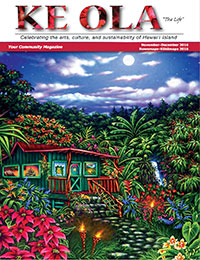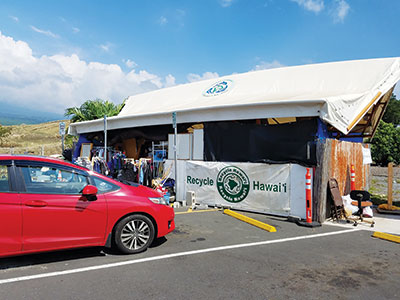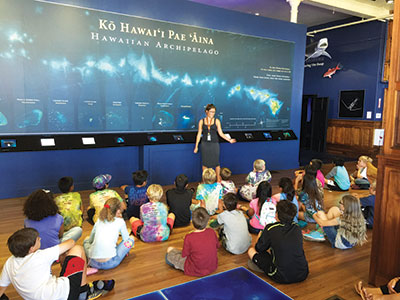Lale Kam: Walking Sunlight, Living Aloha
 By Kate Kealani H Winter
By Kate Kealani H Winter
Lale says her name means “sunshine” in Hawaiian, which seems perfect for this child of Hawai‘i, who has spread aloha across the U.S. for decades.
It also may refer to a legendary bird known as a sweet singer. Also perfect.
As a dancer, musician, singer, and kumu (teacher), Lale Kam has covered the country, and beyond, sharing her talents and the music of Hawai‘i and Polynesia with people who might never get to see those places in person.
Born and raised in Honolulu, Lale lived a mile from Waikīkī. Her older sister, Ihilani “Lani” Miller, took on the role of mother in the ‘ohana (family) after their parents separated, and managed the house and the remaining seven of 10 children.
Theirs was a musical family where both mother and father sang. Lale recalls those days before everyone in the family had a car, all the kids sitting on the lānai making music and playing until Lani started taking them to Kuhio beach, where they would continue to play music while the boys surfed, often at night.
Sister Lani’s well-known song Kuhio Beach was written about the moonlight and good fun there, and Lale relishes telling the backstory about the origin of that mele (song).
Lani had played hooky from school, and when questioned, gave the excuse that she had been stricken with the inspiration to write a song and just had to give in to that creative impulse. Their parents insisted on seeing that song, and Lani quickly composed it. Lale delightedly points out that it is about the pleasures of the beach at night, not during school hours.
When Lale was 15 years old, Lani left home to make her way in the world of Hawaiian entertainment, and Lale took on the role of mother/manager of the household. It is a job she never resented, as some teens might.
Laleʻs aloha and sunny outlook (her mother told her sister that Lale was the “sweet” child in the family), along with her organizational skills, kept things going along happily. Lale kept a chart on the wall with chores and names assigned to them, so everybody shared the work. Lale remembers that everybody had fun: even with so many children, they had a party for every birthday and holiday. No one was left out, and no celebration was slighted.
Lale’s gifts for music and dance bloomed early. She began performing at the age of 10 with a group that included underage musicians and her sister Lani. The “Menehune Maidens” could not perform at venues where alcohol was sold, however they performed at private parties and events around O‘ahu. A photo taken then shows Lale in a cellophane skirt that cost $45, with that “Lale” smile.
Lale studied in Honolulu with Sally Woods, who was also kumu (teacher) at the Polynesian Cultural Center. Lale notes that her life has moved in intersecting lines like the one that took her back to Honolulu in 1976 and to the Polynesian Cultural Center to teach dance. In those days, she was not paid in money, but with admission tickets that she generously shared with her friends and family.
In 1955, at the age of 21, Lale left Hawai‘i for the U.S. mainland. She and a friend had signed a two-year contract to tour in Las Vegas, Chicago, and Florida. She cried all the way to San Francisco, yet with her sunny temperament, she determined to make the best of the choice and the opportunity.

It was, however, a shock to her to witness the prejudices there, especially against African Americans and Jews. Looking back, she believes that she was treated nicely, yet the introduction to racism was harsh in its contradiction of the aloha Lale still lives.
Eventually, she arrived in Florida, where she spent 23 years sharing her talents in lū‘au shows at the big hotels. It was an era of enthusiasm when all things Hawaiian became an important part of American popular culture.
In 1955, Lale reunited with her sister Lani in Florida in a group called “The Vagabonds.”
They did lū‘au shows, and Lale was one of the dancers at a lū‘au catered by a fellow named Raymond Kam. All the island dancers noticed him, for his good looks and that he seemed like he might be from home.
It turned out, he was from O‘ahu, and he noticed Lale, “the one with the longest hair,” out of the group of dancers.
When they met again, he showed up in his well-worn 1929 Ford and asked if she still wanted to go out. She says, “I would have ridden the bus if necessary.”
The next time they went out, he arrived in his 1957 Thunderbird. Apparently, she had passed his test, and the romance turned into a great match.
Months later, Raymond asked Lale to marry him. She gave him every reason why she didn’t want to be a wife yet. The next morning he told her family that they were getting married—much to Lale’s surprise. Later, she gave him a list of terms, which he agreed to, and they were married four months later.
In June 2017, Lale and Raymond will celebrate 60 years of marriage. Their family includes three sons and five grandchildren.
Together they created the “Kam Islanders” Polynesian group, and Ray learned to be a knife dancer to perform in their shows. They were busy doing shows for Miami Grayline Tours and all of the famous hotels in Florida.
Eventually, she and Raymond, her brother Ali‘i Noa and her sister Ihilani Miller all had their own shows, performing at different venues.
Lale also opened a dance studio in Hollywood, Florida where she taught Hawaiian, Samoan, Maori, and Tahitian dance and music. In a shop connected to it, she offered dance implements, island jewelry and fashions, as well as treasures from the Pacific.
Lale’s early affinity for organizing made her a good business woman as well. She and Ray opened the Hawaiian House Restaurant that had her hula studio in the back, a shop in the front, the restaurant, and their lū‘au catering business all under one roof.
They put on one to two shows a night, Lale dancing, playing guitar and ‘ukulele, acting as MC, making the costumes, maintaining them, and training dancers. They performed for the Grand Opening Spectacular for Disney World in 1971 at the Disney Polynesian Village.
Even as their businesses grew, Lale also gave generously to the community by doing programs in nursing homes and fundraising for charities; including the Miami Children’s Hospital and appearing on the Jerry Lewis telethon.
Sometimes in those Florida years, her renown led her down unusual paths. Her agent once booked them to do a “rain dance” in Orlando where there was a drought. The idea was to have them perform some kind of fiery dance to entice the rain to put out the flames and end the dryness. They hesitated because a “rain dance” is not Hawaiian or Polynesian, however, the deal was made. The local news heralded their attempt and urged the public to bring raincoats and umbrellas. A police escort took them to a shopping center, and they did their best. Newspaper clippings tell how it poured down rain when they were done. Requests came for them to repeat their success in other drought-stricken areas, yet Lale and Ray stuck to their business of sharing aloha and declined.
In 1976, Lale was honored by an invitation she felt she could hardly accept at first: she was asked to go to Tahiti to represent Hawai‘i just after the Hōkūle‘a—the Hawaiian voyaging canoe—had left to return to Hawai‘i.
With Raymond willingly and ably taking care of their three children and the businesses, Lale made the trip to Tahiti with her sister Ihilani as chaperone. Touring the island on an air-conditioned bus with three musicians and her round-the-clock bodyguards, the two weeks coincided with Bastille Day celebrations. Lale performed the whole Polynesian array of dance and instruments. Then it was time to return home to Hawai‘i, the same day the Hōkūle‘a arrived from Tahiti.
As often happens in Lale’s life, “bubbles” (as she calls them) intersect mysteriously. In Kailua-Kona, Lale and Ray bought a house that they later discovered was across the road from the house her mother lived in as a little girl before she moved to Kaua‘i.
After beginning to work in Kailua-Kona real estate, Lale went to work for Century 21 at the office that happened to be next to where her mother’s ‘ohana had their beach house in the old days.
Truly, Lale had come home.
When she wasnʻt selling real estate or performing, Lale worked at Hawaii Glass Tinting, the first glass tinting company on the island started by she and her husband in 1978 .
At one of the annual Daughters of Hawai’i events at Keauhou Bay (a celebration for Kamehameha III at his birthplace), Lale was playing solo ‘ukulele. She asked if anyone would play with her and offered to teach anyone who was interested. With that, her weekly ‘ukulele class began.
These days, she can be found on the shady lawn at Hulihe‘e Palace on many Friday mornings with her 24 ‘ukulele students, a group she started, in part to give back to the Daughters of Hawai‘i, Calabash Cousins, and the palace.
Her association with the palace began in 1978 when palace curator Aunty Lei Collins, to whom Lale is related, called and asked for her help. Lale then started as a docent at the royal residence.
Rather quickly, Lale was recruited to join the Daughters of Hawai‘i, the group that saved Hulihe‘e from decay and continues—with the Calabash Cousins—to maintain it as a museum and historical site.
These years in Kailua-Kona have been no “retirement” for Lale. She performed at the Kona Surf for nine years and at countless other venues including Waimea and on Lana‘i.
A handful of citations, certificates, and letters of appreciation from governors, mayors and charitable organizations laud her giving spirit and gifts of time and talent. The American Red Cross named her an “Everyday Hero.” The Daughters of Hawai‘i commended her for her “kōkua and mālama.”
She’s been a busy member of the Kuakini Hawaiian Civic Club since 1995. She entertains at Life Care of Kona with a group of volunteers inspired by her to join in for the experience of spreading aloha to patients. The Regency at Hualalai is a regular stop on her “tour” of Kailua-Kona.
The Kailua-Kona Lions Club has depended on her to coordinate the entertainment for their pancake breakfasts since 1994. With the Lions, she started the Sight Is Beautiful art contest for keiki (children).
Working with Alu Like, she brought the program for Hawaiian elders Ke Ola Pono No Nā Kūpuna to Kailua-Kona where she taught Hawaiian arts, crafts, hula, and song.
Lale says music is her life because it is something to share, and it is inclusive. It brings people together.
When asked what her favorite song is, she says she doesn’t really have one, yet, if she did it would be Smile—and she begins to sing. ❖
Contact writer Kate Kealani H Winter: khwinter@hawaii.rr.com


